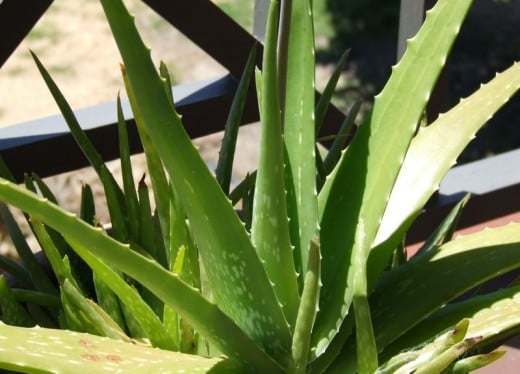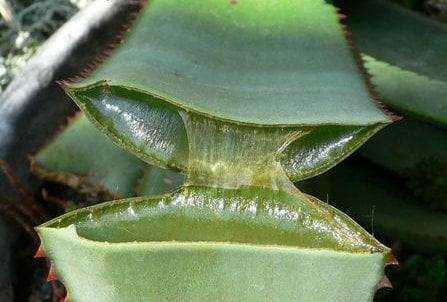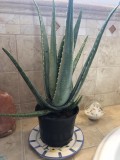What are the Benefits of Aloe Vera
Where Did Aloe Vera Come From
Most research indicates that the Aloe plant, and it's close to 5,000 varieties, originated in Africa. This may sound strange since Mexico is best known for this variety, but when you consider that the tomato, potato, and onion all originated in South America it's not so strange. Much of what we Americans consider local food not only isn't, it got here from across the Atlantic hundreds if not thousands of years ago.
Coffee, tea, and black pepper are all examples. Coffee originated in Ethiopia. Tea from China and black pepper from Southern India.
Aloe Vera has been used by humans for health benefits for a long time. The plant is mentioned in both the Ebers Papyrus from 1600 B.C.E. and Pliny the Elder's Natural History written in the first century C.E.
Aloe Vera (Vera meaning true) is also known as Chinese Aloe, Indian Aloe, true Aloe, Barbados Aloe, and burn Aloe.
Aloe produces two fluids that have different medicinal effects. One, a latex-like compound, called aloin is an irritant and sometimes used as a laxative. Aloin comes from the outer surface of the plant and is often referred to as a sap.
Note that the FDA banned the use of aloin in laxatives in 2002.
The other, aloe vera gel/juice, is said to have wound and burn healing properties and comes from the inner part of the leaf. There is some research that hints that aloe vera juice (from the inner leaf) is also good for acid reflux as well as type two diabetes and elevated levels of blood lipids.
These last two uses have virtually no supporting scientific evidence to back them up in humans. Animal studies have shown the juice has the effect of lowering blood lipids and in treating low blood sugar, however there have been no human studies to date.
Nevertheless only the aloin from the plant is mildly toxic with the inner gel of the plant completely safe to eat or drink.
Note that aloin is a yellowish fluid while the gel is clear and jelly-like in appearance. Again, each of these fluids come from different parts of the plant.


Aloe Vera as Cosmetic
Many cosmetic manufacturers began using Aloe Vera gel in their products. These products range from hand and lip balms to lotions, moisturizers, shampoos, and hair conditioners.
The juice has been used for digestive issues such as heartburn and irritable bowel syndrome.
Cosmetic and home health product companies have used Aloe Vera by adding it to products such as makeup, tissues, moisturizers, soaps, sunscreens, incense, razors and shampoos.
Other uses for the gel of Aloe vera include the addition to sheep semen for the artificial insemination. It has also been used as a fresh food preservative as well as use in water conservation programs in small farms.
Aloe Vera as Food
Aloe Vera Juice
The most common form of Aloe Vera as food is as a drink. These drinks can typically be found in health or organic food stores in plastic bottles in pint (1/2 liter) or quart containers.
Most, if not all, manufacturers of these products tout digestive health and blood "stabilizer" benefits from these drinks. Again, none of these claims are supported by the FDA nor have they been backed up with hard scientific research on humans.
Aloe Vera Dessert
There are a couple of Asian companies selling prepackaged Aloe Vera gel as a dessert. These can be found online and are relatively cheap. About a dollar per ten ounce bag.
I have heard the product described as everything from "too much and too many strong flavors to deal with" to "light floral scents with mild sweetness that is so fleeting as to lead you to believe you imagined the taste."
You can try to make your own dessert (though I have not tried it) by breaking off the larger leaves of the plant, washing those leaves thoroughly, and cutting away the gel from the inside of the leaf. Do not allow any sap to get on the gel. To avoid the same rinse the gel in still water.
Once you have the gel boil it for ten minutes in hot water. Drain on cheesecloth and chill. Serve with powdered or granulated sugar and lime or lemon juice.
Aloe Vera as Ornamental Plant
Aloe is not only an interesting looking plant it is excellent for drought areas or in situations where growing may require a limited use of water.
Aloe does not vine or creep and for that reason keeps a very neat appearance without crowding out or taking over a garden. Aloe grows well in Zones 8 through 11, but can easily be killed off by frost or snow.
Aloe is resistant to most insects, but certain bugs (such as mealy bugs, scale insects and aphids) may inhibit its growth. The plant requires sandy dry soil and bright sunny conditions to thrive. If planting in pots be sure to use the type that drain well; terracotta is recommended. Aloe should not be watered often and in fact potted plants should not be watered at all until the soil is completely dry. In winter months aloe may become dormant. Plants subjected to frost or snow should be taken inside.
Aloe Vera as Topical First Aid
I have direct experience with Aloe Vera as a first aid for burns. Though I have not scientifically documented the effects, my personal experience has been quite good.
I have used it to treat both sunburn and heat (cooking) burns with excellent results. In both these types of cases I used the gel from the inner part of the leaf. To extract the gel I break off one of the many succulent leaves of the aloe at the base.
I then split the leaf along its long axis by bending the leaf out from the center until it breaks open. Using a spoon or my thumb I then push the gel out of the leaf into a small container.
It is also possible to use the split leaf itself as an applicator in order to apply the gel to the burn or wound. The gel is quite cool and sticky, but after about half an hour the gel seems to be absorbed by the skin. In all cases where I've used the gel to treat sunburn I have avoided the dreaded skin peal. It has also helped considerably with the pain of sunburn.
I get almost exactly the same effect with heat burns with a reduction in both pain and the possibility of a blister.
Disclaimer
The author received no monetary compensation in the writing of this article. The author may receive some small profit from ads that are featured with this article, but the author has no control over the content of those ads.
The author has not eaten or drunk any of the preparations mentioned in this article and can not recommend them personally. The author has used the gel as a topical aid and found that it does indeed seem to have beneficial effects.










